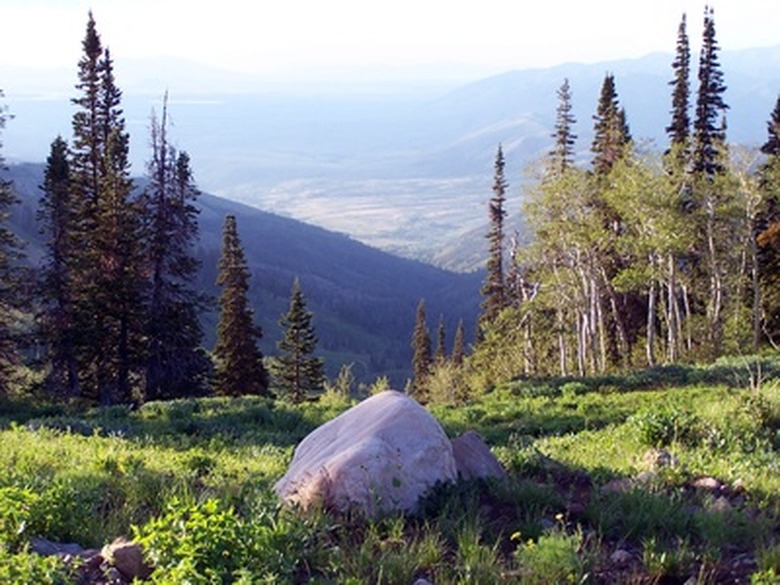Bushes Or Shrubs For Utah
With its snowy winters and sun-filled summers, Utah is a state of extremes. Selecting the right bush or shrub for a yard is not only a matter of personal preference, but also a matter of knowing the soil conditions, weather exposure, available moisture and space limitations. However, there are many varieties that do well in most areas and have the hardiness to survive whatever Mother Nature may send their way.
Serviceberry
The serviceberry (Amelanchier alnifolia) is an adaptable deciduous shrub with four-season interest. It can even be trimmed into a small tree. In early spring, this shrub has showy clusters of small white or lightly pink flowers. New foliage is slightly purple, darkening quickly to deep green, and fall color is a cheerful yellow and red. A western native, the serviceberry is unaffected by cold winters. Birds love the small, dark blue berries. The serviceberry has non-invasive roots, takes full sun well and thrives with ordinary soil and water. It's maximum height is 20 feet, but is usually half that height in home gardens.
- With its snowy winters and sun-filled summers, Utah is a state of extremes.
- New foliage is slightly purple, darkening quickly to deep green, and fall color is a cheerful yellow and red.
Redtwig Dogwood
Redtwig dogwood (Cornus sericea), also known as redstem dogwood, is related to the dogwood tree, but on a smaller scale. It grows as a multi-stemmed deciduous shrub. Small flowers appear in clusters among the leaves in summer and into the fall, but it is the brilliant red fall leaf color that attracts many homeowners. As a bonus, the branches are a bright red in winter, shining cheerfully against the snow. It is a fast growing shrub, reaching nearly 7 feet tall, and may spread by underground runners in the right conditions. It handles the cold, average soil and water and can tolerate some shade. It does not, however, tolerate high salt levels, and so should not be planted where winter de-icers may be used. A yellow variety also exists (yellowtwig dogwood), as does a dwarf variety (C. s. 'Nana') that rarely tops 2 feet. For best stem color, choose your plant in late fall or winter, as it is difficult to see the true shade in spring and summer.
- Redtwig dogwood (Cornus sericea), also known as redstem dogwood, is related to the dogwood tree, but on a smaller scale.
- It is a fast growing shrub, reaching nearly 7 feet tall, and may spread by underground runners in the right conditions.
Curl-leaf Mountain Mahogany
Another large shrub, the curl-leaf mountain mahogany (Cercocarpus ledifolius), is one of the few broad leaf evergreens native to Utah. As the name suggests, its oval ½ to 1 inch long leaves curl under along the edge. This, combined with its open and gnarled growth habit, gives this shrub character, especially with age. In fall, the mountain mahogany sets small fruit topped by showy, fuzzy, curling plumes that make up for a lack of spring interest. It prefers rocky, dry slopes, and is a good choice for low-water landscapes. As an alternative to the usual evergreens, the curl-leaf mahogany is a unique specimen. It grows from 5 to 12 feet high, but grows slowly in colder areas.
- Another large shrub, the curl-leaf mountain mahogany (Cercocarpus ledifolius), is one of the few broad leaf evergreens native to Utah.
Burning Bush
Known as the winged euonymus in other areas of the country, the burning bush (Euonymus alata) is a low-maintenance shrub that looks great with neglect. It is a dense bush with an even, neat growth habit and oval, deep green leaves. E. a. 'Compacta' will be 4 to 5 feet tall when mature, with the common E. alata roughly 2 feet taller. Both can be quite wide when fully grown, sometimes to 10 feet or more, although this is rare in the home garden. The burning bush is often used as a screen or hedge, and only asks for average soil, water and sun to light shade. But even with little care, the burning bush will live up to its name in the fall; the leaves turn a rich, rosy red to red-orange. The fall leaves remain on the shrub for an extended time, adding a welcome dash of color to any yard.
- Known as the winged euonymus in other areas of the country, the burning bush (Euonymus alata) is a low-maintenance shrub that looks great with neglect.
References
- Selection and Culture of Landscape Plants in Utah
- Sunset Western Garden Book; Kathleen Brenzel (Ed.); 1995
